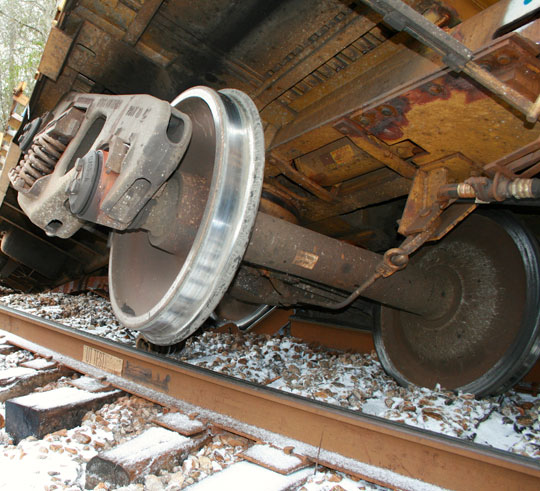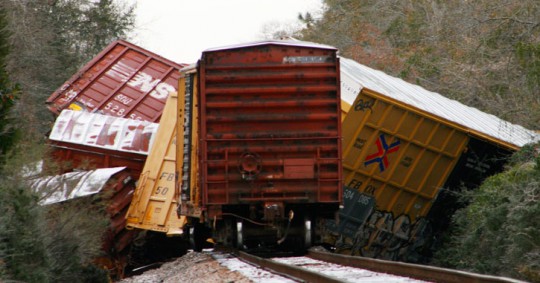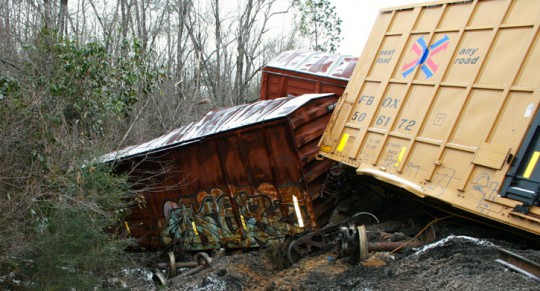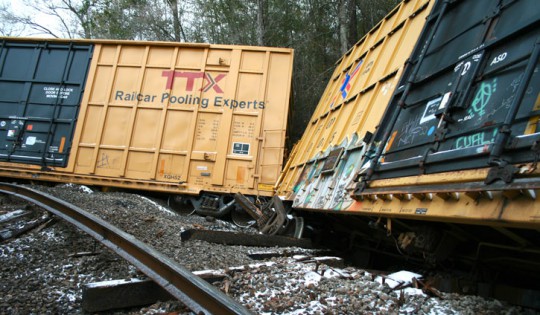Health Alert Issued Following McDavid Train Derailment
January 30, 2014
The Florida Department of Health in Escambia County has issued a health alert following a train derailment Tuesday night in McDavid.
 Twenty-three cars of a 69-car CSX train derailed about 6:20 p.m. on a north-south track almost behind the McDavid Sawmill . Reports from the scene indicated that a bridge and railroad tracks in the area were totally destroyed by the derailment.
Twenty-three cars of a 69-car CSX train derailed about 6:20 p.m. on a north-south track almost behind the McDavid Sawmill . Reports from the scene indicated that a bridge and railroad tracks in the area were totally destroyed by the derailment.
Two tanker cars of phosphoric acid were submerged in Fletcher Creek with other cars landing on top of them. Officials said Wednesday that there was evidence of small leak from one of those cars.
The Florida Department of Health in Escambia County advises against contacting, consuming, or otherwise using, water from Fletcher Creek obtained from the immediate vicinity of the train derailment site.
A small number of homes on Cotton Lake Road were evacuated as a precaution, and an emergency shelter was opened by the America Red Cross at the Molino Community Complex. Just one family took advantage of the shelter before officials gave the all-clear for residents to return to the homes.
An Escambia County spokesman said a crash investigation would be conducted by CSX. He said it may take crews several weeks to make repairs to tracks at the bridge at that location.
Photos by Rebecca Brasch for NorthEscambia.com
Comments
38 Responses to “Health Alert Issued Following McDavid Train Derailment”






Looking at the label on the actual Phosphoric Acid container- “Fire Hazard “0″ Will Not Burn”.
When discussing phosphoric acid,
why reference phosphorus acid?
different animals
We should look at this chemical site http://cameochemicals.noaa.gov/chemical/14846 under the Hazards section under Fire Hazards and Reactivity Profile also in the Response section under Firefighting and also Non-Fire Response or could go to the MSDS hazard sheet http://avogardo.chem.iastate.edu/msds/h3po4.htm and look under Fire Fighting Measures also.
“smoke and fumes from burning phosphoric acid are highly toxic. ”
Autoignition Temperature: Not applicable.
Flash Point: Not applicable.
As in, it doesn’t burn
And while it does react with some finley ground metal, so do many things. It is not especially reactive
CONSIDERING:
“In fact an article in the American Journal Of Clinical Nutrition talks about the link between phosphoric acid in soda, and low bone density. The study suggests that consuming phosphoric acid in soda is believed to decrease bone density/osteoporosis because the excess phosphorous throws off the bodies ability to absorb calcium properly ”
Yep, and other studies suggest lower bone density is related to the fact that people drinking sodas aren’t drinking milk. For certain, it showed only a tendency toward a lowering of bone density if drinking more than two sodas per day over a long period of time, rather than take a drink and bones instantly break.
David for chocolate milk
Thank you William for the information. Some of the other posters may not agree with my questions and that is okay with me because we are all entitled to an opinion. I believe I would be a fool to believe, without question, every word out of Corporate America after all the lies we have been told in the past. Lies told to protect their money and allow their greed to continue. I am fed up – water is kinda just as important as air to humans – and thank God that during the derailment there was no fire or we would be having a much different conversation (phosphoric acid readily reacts with metals to produce highly flammable hydrogen gas) and smoke and fumes from burning phosphoric acid are highly toxic. As for phosphoric acid being in soda – maybe we should question why it is in soda after reading the MSDS hazard sheet on phosphoric acid. In fact an article in the American Journal Of Clinical Nutrition talks about the link between phosphoric acid in soda, and low bone density. The study suggests that consuming phosphoric acid in soda is believed to decrease bone density/osteoporosis because the excess phosphorous throws off the bodies ability to absorb calcium properly ajcn.nutrition.org/content/84/4/936.full
ok ok ok, relax. its seeping out not flowing. its in muck and mire in the creek. its a small small leak. the muck and mire are basically a natural filter. the amount of phosphoric acid seeping into the water may kill some fish. may. the deer drinking the water will most likely not notice or go near the site due to the activity of rebuilding the bridge/trestle. good info put out about phosphoric acid. it sin soft drinks, flip the can around and read the ingredient list. its all about concentrations. parts per million, per million! the train was only moving about 40 in a 45 due to weather. it will never reach the aquifer. it would scare you to death to know the type and amount of hazardous materials moving thru escambia county via road, rail and river. the millions of gallons and tons of product that roll thru here and this is a one in a million accident. look around you, and the things you see and enjoy, eat, use and whater else, guess what yep, they are made from the chemicals that run thru the county. stop the hysteria and educate yourself.
Allison Huskey — you’ll find answers to most of your questions in a special report we have planned on NorthEscambia.com. It will likely run on Monday morning.
These are the things I would like to know… What was in the other train cars that derailed, any other hazardous things? When do they expect the problem to be fixed? Are they going to let the cars completely empty of the phosphoric acid before they pull them out? How much chemical has leaked into the creek? Are they moving in equipment right now, to pull the cars with the posphoric acid out of the creek right now – how much of a proirity is it? Shouldn’t their be a town hall meeting about this issue – people are concerned, and they have questions that deserve answers.
LC50 Lethal to 50% of test fish exposed at the concentration and for the duration
138 mg/ liter 96 hrs Exposure of 96 hours, 4 days kills half the test fish if the concentration is 138 thousandths of a gram per liter which is 138 grams per cubic meter, a little more than a cubic yard
The stuff is put in food and is comparable to the citric acid in an orange, unlikely a small leak would affect much of anything, unlikey even a total rupture would do all that much damage.
Yes, acids react with limestone and such, for example vinegar causes bubbles when poured on marble as the acid in vinegar is neutralized. When neutralized, they no longer react.
David for inorganic chemistry
For the record this train did sound its horn within seconds before it derailed. For how fast it was going I do not know. I was outside my home and heard the train when it derailed. I remember hearing the train horn sound like they do when they go across road crossings and then the next thing I heard sounded like thunder rumbling. But that was not the type weather we were having and at that time the sleet had gotten heavier. And I live about 8 miles southwest of were this happened in Molino.
According to… http://avogadro.chem.iastate.edu/msds/h3po4.htm
Ecotoxicity: Fish: Mosquito Fish: LC50 = 138 mg/L; 96 Hr; Unspecified No data available.
Environmental: The acidity of phosphoric acid may be reduced readily by natural water hardness minerals, but the phosphate may persist indefinitely. During transport through the soil, phosphoric acid will dissolve some of the soil material, in particular, carbonate-based materials. The acid will be neutralized to some degree with adsorption of the proton and phosphate ions also possible. However, significant amounts of acid will remain for transport down toward the groundwater table.
Physical: No information available.
Other: Dangerous to aquatic life in high concentrations.
Now we are going to run the RR out of the country like the oil companies have been done. When the oil spill happened businesses as far away and Monroe county AL submitted claims. The oil companies can’t operate even in the Gulf anymore or no more than they have now. They are going to foreign soil to do business and now you want the RR to be banned. We had some rough weather and none of us are used to it so I’m sure the RR company will fix everything and I hope none of their employees were hurt. Havent’ heard and it seems no one cares.
i live in molino the night it happend train was moving so fast never heard horn. it is like that every day. and i live across street from tracks. so tell that lie again railroad man.
I am going to say this again—–Well if they stop hauling anything dangerous(like gas as an example) by rail or truck get ready to do without a lot of stuff that makes your life easy.
If cold weather “pulled the rail apart”, then it was not installed correctly.
There are thousands of trains running 24/7 in much cold conditions than what we got here.
I suspect rail activity will only increase as more Petro products are shipped by rail to the gulf coast for refinement. However it would be nice if the US implentanted some infrastructure upgrades for high speed rail as the EU ERA have done in the past for continental rail travel.
Me, My Son, and Father in Law fish and hunt on cotton lake. I was there @ 5 am after the wreck. What will happen to that area now. I grew up out there. 1st the oil spill now this. What’s next? I hope nobody gets sick around there.
Wondering why someone who may be concerned the safety of they’re well water following a train derailment/chemical spill is all the sudden anti-railroad. Don’t move near a railroad if your concerned about a train derailment? Just a guess but I’d say if you live in Escambia County you are pr
obably close enough to a railway to be affected by train derailment.
Here is a hazard sheet on Phosphoric Acid http://avogadro.chem.iastate.edu/msds/h3po4.htm I know that some of you like to hunt. Where do you think your deer are drinking? Fish can not even tolerate the tiny amount of chlorine in city water, how are they going to tolerate this chemical as it seeps out…who knows how far? I know that accidents happen and I am so grateful that no one was hurt in the accident, but I want to know why trains were allowed to run with dangerous chemicals, when everywhere else traffic was controlled – roads and highways closed for the weather, why not the railways? Also, I think that to test for specific chemicals in well water you would have to go to a college (like UWF) or an independent water testing company to test specifically for that chemical – normal test kits (like for fish water quality) test for ammonia, nitrite, nitrate, PH (which does test for acid or alkalinity, but it is not the type of acid you would need to test for) and hardness.
Cold weather caused the derailment, it pulled apart the rail causing the derailment
@biscuit speeding was not a factor in this in fact he was doing under the speed limit just getting that straight
Don’t forget why the RR does for this nation, if u don’t like the trains coming by where u wanted to purchase a house then move. I hear Detroit is nice this time of the year!
to Jimmy r
I don’t live near the tracks. but we all live on top of the aquifer. and weather you get your water from a privet well, or buy it from molino water. It all comes from the same aquifer. and if acid get in the aquifer all of the water in contemanated.
CONCERNING:
“It is a fertilizer and can cause algal bloom in rivers causing oxygen depletion. ”
But it would take a steady resupply to make it happen,
not a small, one-time leak highly diluted.
We need to figure out a cost effecive way to harvest the algal blooms for use as animal feed.
David for lemons into lemonade
Well if they stop hauling anything dangerous(like gas as an example) by rail or truck get ready to do without a lot of stuff that makes your life easy.
Phosphoric acid is used in many things including soft drinks. The acidity of the creek should not change much bcause of the dilution factor . The element phosphorus will bind with other minerals and should not reach groundwater and is not harmful at low concentrations. It is a fertilizer and can cause algal bloom in rivers causing oxygen depletion. There is far more lethal cargo on trains.
CSX is more than capable of keeping these chemicals from getting into the river system…they have well qualified…educated and trained employees just for accidents like this…I guarantee there are people there 24/7 from CSX enviromental and local environmental people…along with contractors handling and monitoring it this very moment…so rest easy my friends…its in good hands
I’ll bet the 1/4 inch of ice didn’t cause this, but speeding did. These trains fly down those tracks.
I also use a well to draw water from the aquifer, I recommend buying a test kit as I have done. Being next to these farms and with pesticide run off keep’s me on my toes.
Is this the same phosphoric acid they put in soft drinks?
@Richard. I was concerned about that too. I dont use a well, but I use the river. As for CSX paying for your tests. It would be a nice gesture, but it was not anything they did wrong. It was the ice. (as far as we know right now)
Does this creek flow into Escambia River?
If the tanker is leaking acid into Fletcher creek it will end up in Escambia river.
You should test your well yearly regardless of a train derailment nearby….at your own expense.
Hoping there isn’t contamination to the water table in our area. How many other toxic chemicals are being transported through this area? Is it going to contaminate the water from Molino Utilities at some point? Anyone know the answers?
Which was there first, your well or the train track? Sounds like people who build next to an airbase and then complain over jet noise.
are these chemicals going to reach the aquifer I get my water from a well. I will start having my well tested and I belive the rail company should pay for the test.